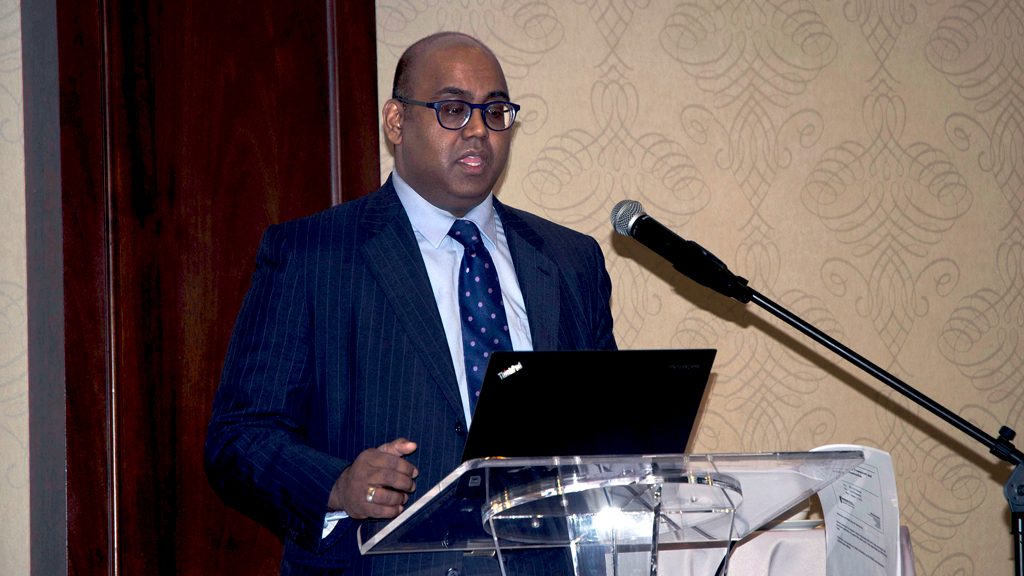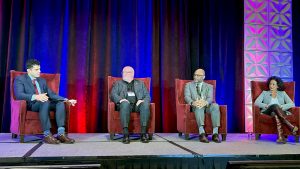The Workplace Safety and Insurance Board (WSIB) rate framework modernization is going to be a priority issue for many construction associations in the next few years as it gears up to launch in 2020.
The Residential Construction Council of Ontario (RESCON) and the Ontario Sewer and Watermain Construction Association (OSWCA) recently hosted an information session on the draft rate framework at Eagle’s Nest Golf Course in Maple, Ont.
“The rate framework review is going from the theoretical to the practical. It’s going to mean something now. It’s going to mean dollars and cents,” said Andrew Pariser, vice-president of RESCON. “They haven’t gotten it right yet. We’re hoping they do get it right but they still need to do some tweaks and there are some changes needed.”
Daryl Seupersad of Sherrard Kuzz LLP, who led the discussion, focused on four out of the seven draft policies: classification structure, employer level premium setting, eligibility for single or multiple rates and associated employers.
“This is the biggest change to WSIB premiums and policy since the early ‘90s,” said Seupersad. “2020 is two years away but there are things employers can start doing now to get ahead of the changes that are coming.
“Currently employers are assigned a rate group. They pay the premium of that rate group and then based on their claims history for five years prior to the premium year, they are assessed either a surcharge or a rebate based on that history,” explained Seupersad. “On Jan. 1, 2020 that system will no longer exist. It will be replaced by a single prospective premium rate setting system.”
The current system of classification of employer business activities (i.e. rate groups) is being replaced with the North American Industry Classification System. Under the new system there will be 34 classes based on prominent business activity.
“They’re getting rid of the over 150 rate groups that currently exist in the WSIB rate premium policy,” said Seupersad. “Each class will have a projected class premium rate and that will be used to set the employer individual agreement rate. These classes are grouped together based on the sharing of what they call ‘occupational risk of the industry’ and the size of the total reportable class payroll, as each class is expected to fund itself.”
Focusing specifically on construction, Class G would go from 13 rate groups to five subclasses: building construction, infrastructure construction, foundation, structure and building exterior construction, and building and equipment construction, specialty trades.
Seupersad also offered tips including making sure you received your new classification from the WSIB and ordering a copy of your account file from the WSIB to confirm the current classification as errors may transition into the new system.
“There were so many misclassifications in the 1990s process, it took years to sort out,” Seupersad said. “If you have an issue for appeal you should do that sooner than later because employer account appeals tend to move slowly through the system.”
A big change with respect to the employer level premium setting is that the WSIB will consider claims for six years prior. For example, in the premium setting for 2021, which occurs in 2020, the WSIB will consider 2014 to 2019 with the three most recent years weighted at 66.6 per cent and the earlier three years weighted at 33.3 per cent.
“So if you think about 2021, the years that are going to cost the most are 2017, 2018, 2019. Claims during this time will have a bigger impact on our future premiums,” Seupersad noted.
Tips he shared with those in attendance regarding premium rates were to manage current claims to save time in the future, challenge initial entitlement, manage returns to work and minimize payment of loss of earnings benefits.
Under the new system, employers may still have multiple classifications but it won’t be easy, Seupersad said.
“Under the new system, an employer must show they are entitled to multiple classifications — that the business activity that you are saying should have a separate classification is significant,” he said. “Twenty-five per cent of total insurable earnings or that business activity generates five times the maximum insurable earnings and is separate from the other operation. That’s a huge amount. A lot of the smaller employers are saying that’s my total payroll.”
He also said another issue that may impact employers under the new policy is the associated employer test.
“The WSIB looks at two employers that are separate entities that may have the same people on the board of directors or may be run by family within the two corporations for rate setting purposes. The two employers are actually associated employers and they treat them as one employer,” Seupersad said. “The two employers have to be affiliated and engaged in a co-operative business relationship… a new term in the policy and it’s a term that they actually don’t really define.”











Recent Comments
comments for this post are closed